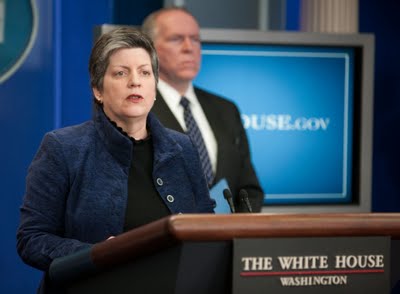 The President spoke to the American public this afternoon, outlining the details in the White House's report on the failed Christmas Day terrorist attack. The report itself focuses on the shortcomings related to intelligence collection, sharing and integration within the intelligence community. You can download a pdf copy of the report here:
The President spoke to the American public this afternoon, outlining the details in the White House's report on the failed Christmas Day terrorist attack. The report itself focuses on the shortcomings related to intelligence collection, sharing and integration within the intelligence community. You can download a pdf copy of the report here:
Read the summary of the security review
The President simultaneously issued a directive for multiple federal departments and agencies, ordering corrective actions with respect to intelligence, screening, and watchlisting systems and programs. Relevant to this blog, the President ordered DHS to undertake the following:
- Aggressively pursue enhanced screening technology, protocols, and procedures, especially in regard to aviation and other transportation sectors, consistent with privacy rights and civil liberties; strengthen international partnerships and coordination on aviation security issues.
- Develop recommendations on long-term law enforcement requirements for aviation security in coordination with the Department of Justice.
You can download the full pdf version of the President's directive here:
Read the President's Directive on corrective actions (pdf).
Secretary Napolitano, Deputy National Security Advisor John Brennan, and Robert Gibbs briefed the press shortly after the President's statement, delving further into the report and detailing the recommendations and findings within.
The Secretary discussed the immediate steps DHS took after the attempted attack, noting that DHS strengthened screening requirements for passengers entering the United States and deployed additional law enforcement officers, behavior detection officers, and explosive detection K-9 units to airports across the country. It's worth mentioning that while these additional measures are both seen and unseen, that they add to the "layers of security" already in place at airports and on airplanes traveling to and from the United States.
The Secretary also outlined five long-term steps the department is taking to correct the shortcomings that led to the attempted attack:
- Re-evaluate and modify the process for creation and modification of terror "watchlists" - including adjusting the process by which names are added to the “No-Fly” and “Selectee” lists.
- Establish a partnership on aviation security between DHS and the Department of Energy and its National Laboratories in order to develop new and more effective technologies to deter and disrupt known threats and proactively anticipate and protect against new ways by which terrorists could seek to board an aircraft.
- Accelerate deployment of advanced imaging technology to provide greater explosives detection capabilities—and encourage foreign aviation security authorities to do the same—in order to identify materials such as those used in the attempted Dec. 25 attack. The Transportation Security Administration currently has 40 machines deployed throughout the United States, and plans to deploy at least 300 additional units in 2010.
- Strengthen the presence and capacity of aviation law enforcement—by deploying law enforcement officers from across DHS to serve as Federal Air Marshals to increase security aboard U.S.-bound flights.
- Work with the Department of State to strengthen international cooperation on aviation security measures, ensuring that we have a consistent system to screen passengers flying to the United States from countries around the world. As I write this, senior department officials - led by Deputy Secretary Jane Holl Lute - are on a multi-country, multi-continent mission to begin this process, and Secretary Napolitano will travel to Spain later this month to meet with her international counterparts in the first of a series of global meetings intended to bring about broad consensus on new international aviation security standards and procedures.
John Brennan mentioned this afternoon that our intelligence and homeland security communities have made significant progress since 9/11. That's true. Our work, however, is never finished, as we face evolving threats and new intelligence each day. We'll keep you up-to-date on our progress in the weeks and months to come.
Published by the U.S. Department of Homeland Security, Washington, D.C.
